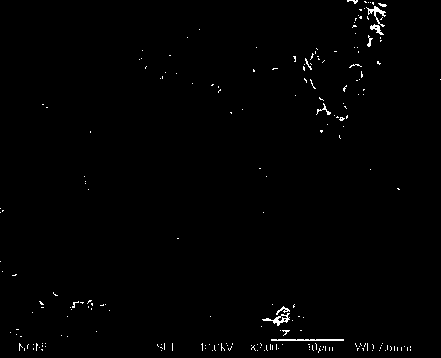Method for regenerating engine oil by using biomass wastes
A technology for biomass waste and waste oil, applied in chemical instruments and methods, alkali metal oxides/hydroxides, inorganic chemistry, etc., can solve problems such as environmental pollution and waste of biomass resources, and achieve good adsorption performance, The effect of solving waste problems, significant economic benefits and social value
- Summary
- Abstract
- Description
- Claims
- Application Information
AI Technical Summary
Problems solved by technology
Method used
Image
Examples
Embodiment 1
[0022] A method for regenerating waste engine oil from biomass waste, the steps are as follows:
[0023] 1) Crush the walnut shell waste to obtain particles with a particle size of 1mm, wash with deionized water to remove impurities, dry at 105°C for 4 hours, and set aside;
[0024] 2) Add the dried walnut shells to a phosphoric acid solution with a concentration of 40wt%, with a liquid-solid mass ratio of 1:1, carbonize at 400°C for 0.5h under the protection of nitrogen, and then raise the temperature to 600°C for 60min to activate the obtained The product was pickled with 3% sulfuric acid by mass percentage, then washed with water until neutral, dried at 105-110°C for 2 hours, and cooled to room temperature to obtain activated carbon from walnut shell biomass. The attached figure shows the activated carbon from walnut shell biomass under this condition scanning electron microscope;
[0025] 3) After the waste engine oil is left to stand, it is separated into layers, the wat...
Embodiment 2
[0028] A method for regenerating waste engine oil from biomass waste, the steps are as follows:
[0029] 1) Crush the peanut shell waste to obtain particles with a particle size of 1mm, wash with deionized water to remove impurities, dry at 105°C for 3 hours, and set aside;
[0030] 2) Carbonize the dried peanut shells at 850°C for 1 hour under the protection of nitrogen, pickle the obtained product with hydrochloric acid with a concentration of 4% by mass percentage, then wash with water until neutral, dry at 105-110°C for 2 hours, and cool to room temperature , to prepare peanut shell biochar;
[0031] 3) After the waste engine oil is left to stand, it is separated into layers, the water in the lower layer is removed, and then the solids and suspended matter are filtered to obtain the treated waste engine oil;
[0032] 4) Heat the above treated waste engine oil to 60°C, add peanut shell biochar under continuous stirring, the ratio of peanut shell biochar to waste engine oil...
Embodiment 3
[0034] A method for regenerating waste engine oil from biomass waste, the steps are as follows:
[0035] 1) Crush the dried sludge from the sewage treatment plant to obtain particles with a particle size of 0.5mm, wash with deionized water to remove impurities, dry at 105°C for 5 hours, and set aside;
[0036] 2) Carbonize the dried sludge at 300°C for 1 hour under the protection of nitrogen, activate it with water vapor at 500°C for 0.5 hour, pickle the obtained product with hydrochloric acid with a concentration of 10% by mass, then wash it with water until neutral, Dry at -110°C for 2 hours and cool to room temperature to prepare activated carbon from sludge biomass;
[0037] 3) After the waste engine oil is left to stand, it is separated into layers, the water in the lower layer is removed, and then the solids and suspended matter are filtered to obtain the treated waste engine oil;
[0038] 4) Heat the above treated waste engine oil to 120°C, add sludge activated carbon ...
PUM
| Property | Measurement | Unit |
|---|---|---|
| particle diameter | aaaaa | aaaaa |
| particle diameter | aaaaa | aaaaa |
| particle diameter | aaaaa | aaaaa |
Abstract
Description
Claims
Application Information
 Login to View More
Login to View More - R&D
- Intellectual Property
- Life Sciences
- Materials
- Tech Scout
- Unparalleled Data Quality
- Higher Quality Content
- 60% Fewer Hallucinations
Browse by: Latest US Patents, China's latest patents, Technical Efficacy Thesaurus, Application Domain, Technology Topic, Popular Technical Reports.
© 2025 PatSnap. All rights reserved.Legal|Privacy policy|Modern Slavery Act Transparency Statement|Sitemap|About US| Contact US: help@patsnap.com

